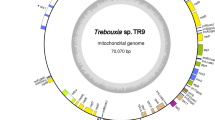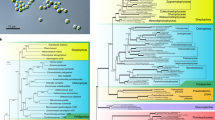Abstract
PROCHLOROPHYTES are prokaryotes that carry out oxygenic photosynthesis using chlorophylls a and b, but lack phycobili-proteins as light-harvesting pigments1. These characteristics distinguish them from cyanobacteria, which contain phycobiliproteins, but no chlorophyll b. Three prochlorophyte genera have been described: Prochloron1–3,Prochlorothrix4andProchlorococcus5,6. The prochlorophytes share their pigment characteristics with green plant and euglenoid chloroplasts, which has led to a debate on whether these chloroplasts may have arisen from an endosymbiotic prochlorophyte rather than a cyanobacterium2,7. Molecular sequence data, including those presented here based on a fragment of the rpoCl gene encoding a subunit of DNA-dependent RNA polymerase, indicate that the known prochlorophyte lineages do not include the direct ancestor of chloroplasts8–11. We also show that the prochlorophytes are a highly diverged polyphyletic group. Thus the use of chlorophyll b as a light-harvesting pigment has developed independently several times in evolution. Similar conclusions have been reached in parallel studies using 16S ribosomal RNA sequences12.
This is a preview of subscription content, access via your institution
Access options
Subscribe to this journal
Receive 51 print issues and online access
$199.00 per year
only $3.90 per issue
Buy this article
- Purchase on Springer Link
- Instant access to full article PDF
Prices may be subject to local taxes which are calculated during checkout
Similar content being viewed by others
References
Lewin, R. A. Nature 261, 697–698 (1976).
Lewin, R. A. & Cheng, L. (eds) Prochloron, a Microbial Enigma (Chapman & Hall, New York, 1989).
Lewin, R. A. Phycologia 14, 153–160 (1975).
Burger-Wiersma, T., Veenhuis, M., Korthals, H. J. Van de Wiel, C. C. M. & Mur, L. R. Nature 320, 262–264 (1986).
Chisholm, S. W. et al. Nature 334, 340–343 (1988).
Chisholm, S. W. et al. Arch. Mikrobiol. (in the press).
Cavalier-Smith, T. Biol. J. Linn. Soc. Lond. 17, 289–306 (1982).
Turner, S., Burger-Wiersma, T., Giovannoni, S. J., Mur, L. R. & Pace, N. R. Nature 337, 380–382 (1989).
Morden, C. W. & Golden, S. S. J. molec. Evol. 32, 379–395 (1991).
Kishino, H., Miyata, T. & Hasegawa, M. J. molec. Evol. 31, 151–160 (1990).
Stackebrandt, E. in Prochloron, a Microbial Enigma (eds Lewin, R. A. & Cheng, L.) 65–69 (Chapman & Hall, New York, 1989).
Urbach, E., Robertson, D. & Chisholm, S. W. Nature 355, 267–270 (1992).
Schneider, G. J., Tumer, N. E., Richaud, C., Borbely, G. & Haselkorn, R. J. biol. Chem. 262, 14633–14639 (1987).
Schneider, G. J. & Haselkorn, R. J. Bact. 170, 4136–4140 (1988).
Bergsland, K. J. & Haselkorn, R. J. Bact. 173, 3446–3455 (1991).
Puehler, G. et al. Proc. natn. Acad. Sci. U.S.A. 86, 4569–4573 (1989).
Jaynes, J. M. & Vernon, L. P. Trends Biochem. Sci. 7, 22–24 (1982).
Giovannoni, S. J. et al. J. Bact. 170, 3584–3592 (1988).
Morden, C. W. & Golden, S. S. Nature 337, 382–384 (1989).
Morden, C. W. & Golden, S. S. Nature 339, 400 (1989).
Felsenstein, J. Cladistics 5, 164–166 (1989).
Felsenstein, J. Evolution, 39, 783–791 (1985).
Igloi, G. L., Meinke, A., Döry, I. & Kössel, H. Molec. Gen. Genet. 221, 379–394 (1990).
Hudson, G. S., Holton, T. A., Whitfeld, P.R. & Bottomley, W. J. molec. Biol. 200, 639–654 (1988).
Ohyama, K. et al. Nature 322, 572–574 (1986).
Ovchinnikov, Y. A. et al. Nucleic Acids Res. 10, 4035–4044 (1982).
Borodin, A. M. et al. Bioorg. Khim. 14, 1179–1182 (1988).
Higgins, D. G. & Sharp, P. M. Gene 73, 237–244 (1989).
Author information
Authors and Affiliations
Rights and permissions
About this article
Cite this article
Palenik, B., Haselkorn, R. Multiple evolutionary origins of prochlorophytes, the chlorophyllb-containing prokaryotes. Nature 355, 265–267 (1992). https://doi.org/10.1038/355265a0
Received:
Accepted:
Issue Date:
DOI: https://doi.org/10.1038/355265a0
This article is cited by
-
Welcome to the jungle!: An overview of modern taxonomy of cyanobacteria
Hydrobiologia (2024)
-
Phylogenetic and spectroscopic insights on the evolution of core antenna proteins in cyanobacteria
Photosynthesis Research (2023)
-
Membrane organization of photosystem I complexes in the most abundant phototroph on Earth
Nature Plants (2019)
-
A novel species of the marine cyanobacterium Acaryochloris with a unique pigment content and lifestyle
Scientific Reports (2018)
-
The identification of IsiA proteins binding chlorophyll d in the cyanobacterium Acaryochloris marina
Photosynthesis Research (2018)
Comments
By submitting a comment you agree to abide by our Terms and Community Guidelines. If you find something abusive or that does not comply with our terms or guidelines please flag it as inappropriate.



